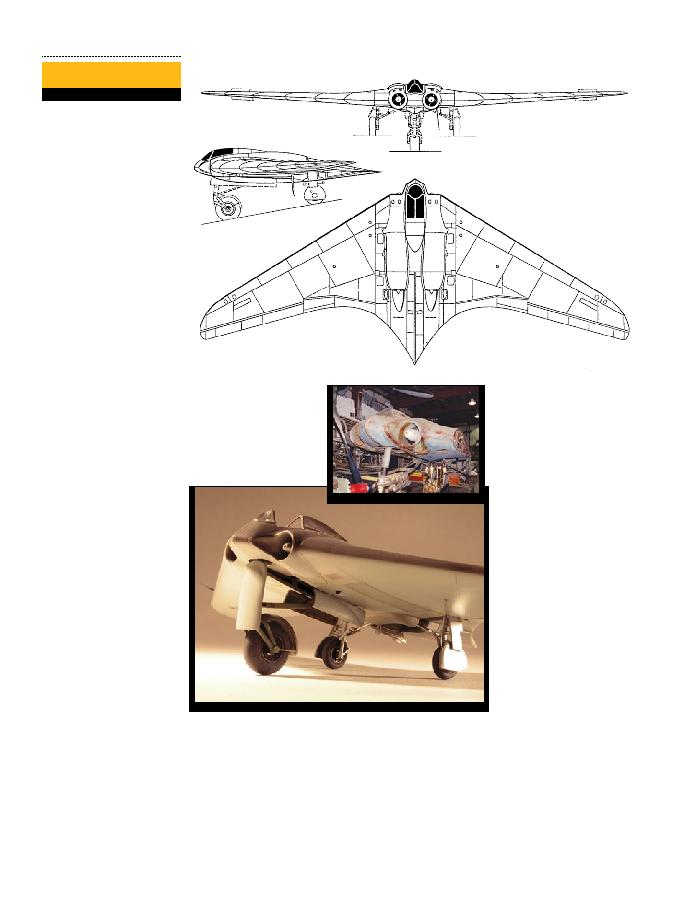
32
GA
/ Vol. 5 / No.4 / APRIL 2013
Of all the weapons designed by Nazi
Germany at the end of WWII, the
Horton Hi IX Delta wing fighter/
bomber was probably one of the
most imaginable. The design was
decades ahead of other aircraft
designs and it was said to be the first
'stealth' aircraft, a description often
applied since the appearance of the
B-2 Spirit flying wing stealth bomber
in the 1990s, with its similarities
in role and shape to the Ho 229.
This has been so hotly
disputed that in 2009 National
Geographic made a documentary
of the construction of the Horton
Ho IX together with the Northrop
Corporation. The aim was to
determine once and for all whether
the Ho IX had stealth capabilities.
Experts first examined the surviving
2-29 and probed it with a portable
radar unit based on World War
II radar technology. In the fall of
the winter of 2008 engineers from
the Northrop Grumman Defence
Corporation started to work on a full
scale reproduction model based on
the original blueprints of the aircraft.
The Horten Ho IX is made largely of
wood and bonded with glue and nails.
The end result of this was that,
based on the British Radar technology
of 1945, the Ho IX proved to have
had stealth capabilities with a radar
pick up reduction of 20%. Together
with it's tremendous speed the Ho
IX would have been picked up by
the British early warning ground-
based radar that operated at 20 to 30
MHz, known as Chain Home, only 8
minutes after arrival on British soil
in contrast to the usual 19 minutes
for the average WW II plane.
However it would have no stealth
capabilities against modern radar.
The design of the Ho IX was
given the personal approval of
German Luftwaffen Reichsmarschall,
Hermann Goring, and was the
only aircraft to come close to
meeting his "3×1000" performance
requirements, (issued in 1943),
namely to carry 1,000 kilograms
(2,200lb) of bombs a distance of
1,000km (620mi) with a speed of
1,000 kilometres per hour (620mph).
Its ceiling was 15,000m (49,000ft).
Design and development
Conventional German bombers
could reach Allied command centers
in Great Britain, but were suffering
devastating losses from Allied
fighters. At the time, there was no way
to meet the goals set by Goring. The
new Junkers Jumo 004B turbojets
could provide the required speed, but
had excessive fuel consumption.
The Hortens decided that the
low-drag flying wing design could
meet all of the goals: by reducing
the drag, cruise power could be
lowered to the point where the range
requirement could be met. They put
forward their private project, the
H.IX, as the basis for the bomber
and this was accepted by the German
Air Ministry but they ordered the
addition of two 30mm cannons, as
they felt the aircraft would also be
useful as a fighter due to its estimated
top speed being significantly higher
than that of any Allied aircraft.
The H.IX was of mixed
construction, with the center pod
made from welded steel tubing and
by Cesaré de Villiers
Military History
Horten H.IX
Stealth Aircraft
of WWII
wing spars built from wood. The
wings were made from two thin,
carbon-impregnated plywood panels
glued together with a charcoal and
sawdust mixture. The wing had a
single main spar, penetrated by the
jet engine inlets, and a secondary
spar used for attaching the elevons.
It was designed with a 7g load factor
and a 1.8x safety rating; therefore,
the aircraft had a 12.6g ultimate load
rating. The wing's chord/thickness
ratio ranged from 15% at the root
to 8% at the wingtips.The aircraft
used retractable tricycle landing gear
with the nose gear on the first two
prototypes with the third prototype
using a He 177A main gear wheel
rim and tire on its custom-designed
nose gear strut work and wheel fork.
The nosewheel retracted rearwards
under the cockpit floor whilst the two
main landing gears recessed inwards
towards the fuselage just under
the wingroots. A drogue parachute
slowed the aircraft upon landing. The
pilot sat on a primitive ejection seat.
It was originally designed for the
BMW 003 jet engine, but that engine
was not quite ready and the Junkers
Umo 004 engine was substituted.
Control was achieved with
elevons and spoilers. The control
system included both long span
(inboard) and short span (outboard)
spoilers, with the smaller outboard
spoilers activated first. This
system gave a smoother and more
graceful control of yaw than
would a single spoiler system.
Wood in the construction of
the IX proved a natural choice as
it was relatively available, readily
accessible and required very little
training to work with. Considering
the manufacturing restrictions
imposed against the German war
Right: Horten Ho 229 V3 prototype
at the Smithsonian's Garber
restoration facility (National
Air and Space Museum).
Below: Angled view of the Horten
H.I.X showing wheels
extended. The Horten never
flew during WWII and only the
centre fuselage was found.
Horten Ho IX

